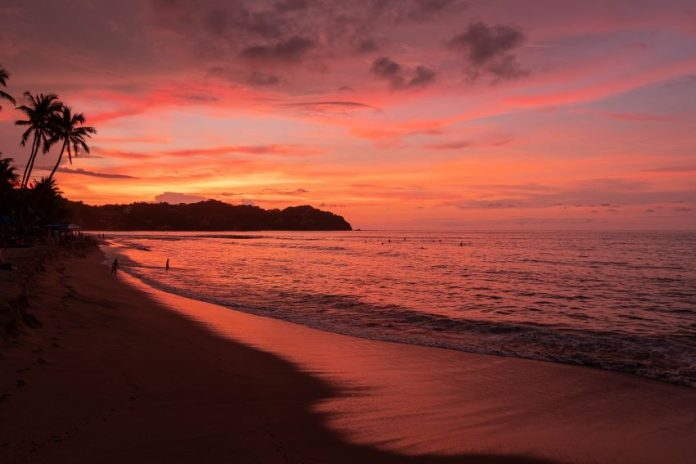Mexico has no shortage of fabulous beach destinations, but one that is consistently full of surprises is the Rivera Nayarit. This band of coastal communities consists of 23 micro-destinations that extend for about 200 miles north from Puerto Vallarta along the coast of the state of Nayarit.
Riviera Nayarit is first and foremost a beach destination, but when you dig a little deeper beneath its golden-hued sand, you’ll discover that its many destinations are quite different and cater to nearly every type of traveler.
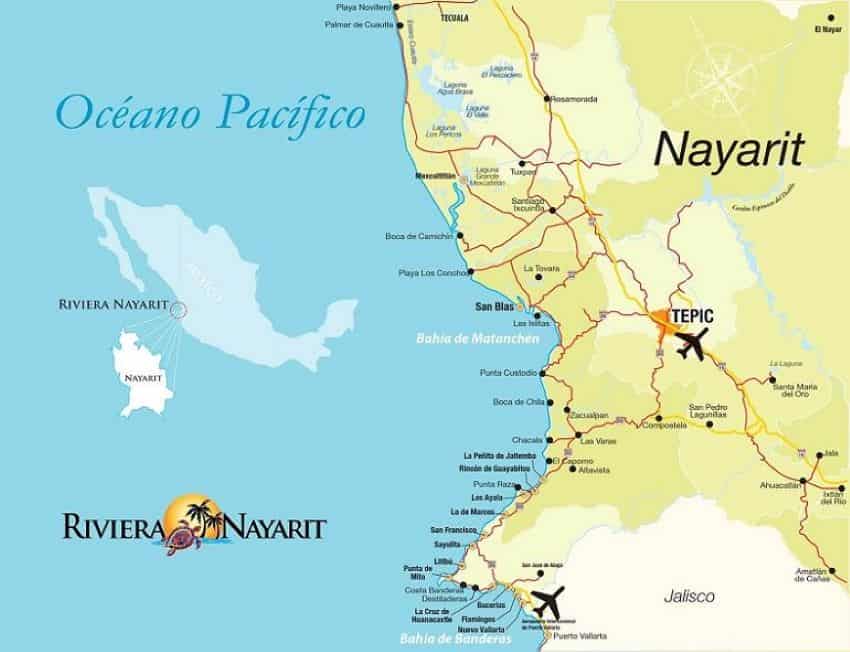
From the all-inclusive die-hards to those who want to disappear into a Daniel Defoe novel, from the professional surfers to the amateur snorkelers, the boho-chic to the barefoot casual, Riviera Nayarit is the perfect background to a dreamy vacation.
But which town is which and who will be drawn to what? I’ve broken it down into the basics about what to expect from each of the main beach towns along the Riviera Nayarit.
Nuevo Vallarta
Crossing over the border from the Puerto Vallarta International Airport will put you at the doorstep of the Riviera Nayarit in its only major city, Nuevo Nayarit. Don’t be concerned if you don’t recognize the name Nuevo Nayarit. Up until 2022, it was called Nuevo Vallarta and was built almost as an extension of Puerto Vallarta. But it has recently gone through a destination rebrand and now goes by Nuevo Nayarit. Same city, new name.
In any event, Nuevo Nayarit is where you’ll find many of the all-inclusive resorts of the Riviera Nayarit. Smaller boutique hotels or international five-star brand names define the rest of the coastline. The most variety of chain resorts and all-inclusive are in Nuevo Nayarit.
If you’re looking for an all-inclusive resort on a beautiful stretch of beach, Nuevo Nayarit is where it’s at. While Puerto Vallarta has its own list of all-inclusive resorts, the beaches in Puerto Vallarta proper leave much to be desired. Nuevo Nayarit got all the riches when it comes to the fabulous beachfront.
Outside of the hotel sphere, you won’t find too much going on in Nuevo Nayarit. For the more charming beach towns and slice of local life, you’re going to want to keep on moving north.
Bucerías
Though it’s just up the coast from Nuevo Vallarta, Bucerías feels like another world. This small seaside town has grown in popularity over the years, but it still retains a sleepy vibe with its sandy streets, residential rentals, charming restaurants and shops, and boutique hotels. It’s a town that has a little bit of everything, particularly for people who feel overwhelmed by the traffic and noise of Puerto Vallarta, but don’t want to be too far away from major services.
Bucerías is all about color, from the low-rise building facades and beachfront umbrellas to the rainbow of fresh food you can find in its delightful restaurants. You’ll find most tourists camped out with their toes in the sand at the long string of beach bars that overlook the water.
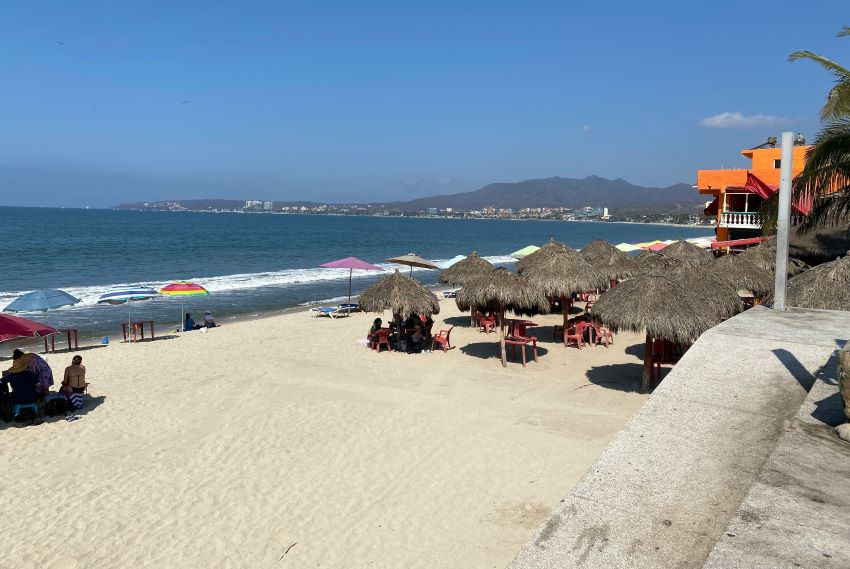
Off the beach, Bucerías has a treasure trove of hidden gems, from El Eden Botanical Garden to food tours and art walks. Don’t leave Bucerías without trying the regional treats at Los Dorados de Villa Birria. Birria is a slow-cooked breakfast stew made with goat meat or beef, heaped high atop tortillas. For seafood, Lamara is known for its incredible ceviche. There are two other locations in Puerto Vallarta, and the one in Bucerías is just as excellent.
Other top activities in Bucerías include whale watching, sailing, kiteboarding, fishing, and releasing baby sea turtles, which is a heartwarming and rewarding activity available up and down the coast of Nayarit.
La Cruz de Huanacaxtle
Things get even quieter as you move up the coast to the village of La Cruz de Huanacaxtle. Shortened to “La Cruz,” this sleepy seaside town wows with natural beauty, from its rolling, jungle-covered hills to the beautiful beaches.
Things have gotten swankier in La Cruz over the years, particularly in the marina. In 2008, the harbor was renovated to become Marina Riviera Nayarit and has more than 300 slips that can accommodate boats up to 400 feet in length. It even has a yacht club, complete with a sky bar, so La Cruz can be an interesting display of contrasts.
What most people come to La Cruz for is the seafood market. This bustling, colorful, energetic spot has more than a dozen vendors selling the freshest daily catch. What’s great is that the vendors will also give you tips on how to cook whatever you purchase. Choose from the ubiquitous mahi-mahi to plump shrimp, tuna, octopus, oysters — you name it!
Speaking of shopping, La Cruz hosts a weekly Sunday Farmer’s Market (from November to April), yet another colorful, swirling sight to see, with around 200 vendors in attendance. Be sure to bring plenty of cash — you’re guaranteed to find more than a few things to take home with you.
Punta de Mita
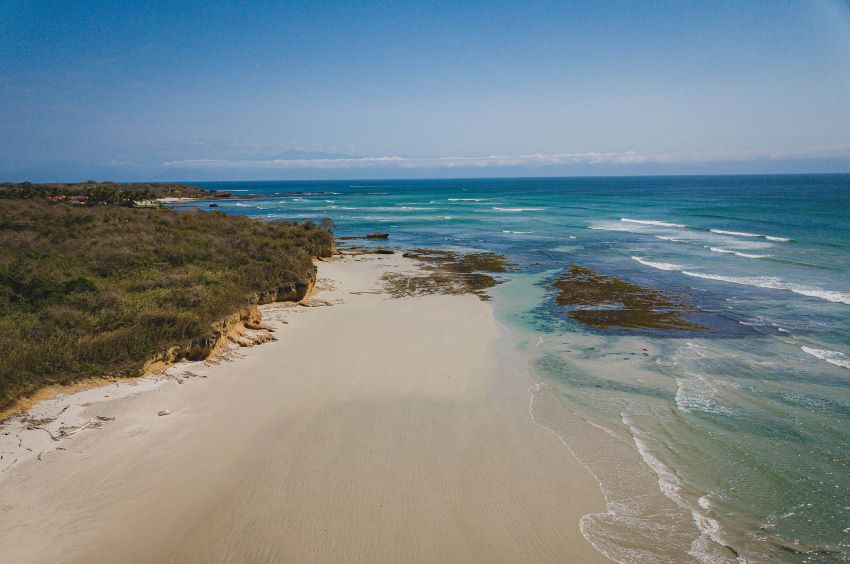
Bookending the northern end of the Bay of Banderas is a diamond-shaped peninsula known for its town, Punta de Mita. This is not to be confused with Punta Mita, which is the 1,500-acre private gated community home to the St. Regis and Four Seasons — Punta de Mita is the actual beachfront town, completely separate from the nearby five-star resorts and golf club.
Most people who are coming to the peninsula are staying within the confines of Punta Mita. While the gated community is beautiful, and its resorts are among the best in Nayarit, it is certainly exclusive and comes at a high price tag. Punta de Mita still swings decidedly high-end but offers many more approachable opportunities for travelers on a less extravagant budget.
This small town is packed with great restaurants and boutique shopping. Grab a beachfront table at Zicatela for ocean views and ceviche tostadas heaped high with aguachile or octopus. The fish tacos are superb here, as well.
Like many of the towns along the Riviera Nayarit, Punta de Mita is a great jumping-off point to explore the nearby Islas Marietas National Park (home to the famous, overly-Instagrammed Hidden Beach), go surfing, whale watching, kiteboarding, or snorkeling. It’s an adventurous destination but with plenty of creature comforts and a bohemian beachfront energy. Punta de Mita is also the last stop along the Bay of Banderas before you begin to hit the Pacific Ocean-facing beach towns of Riviera Nayarit.
Sayulita
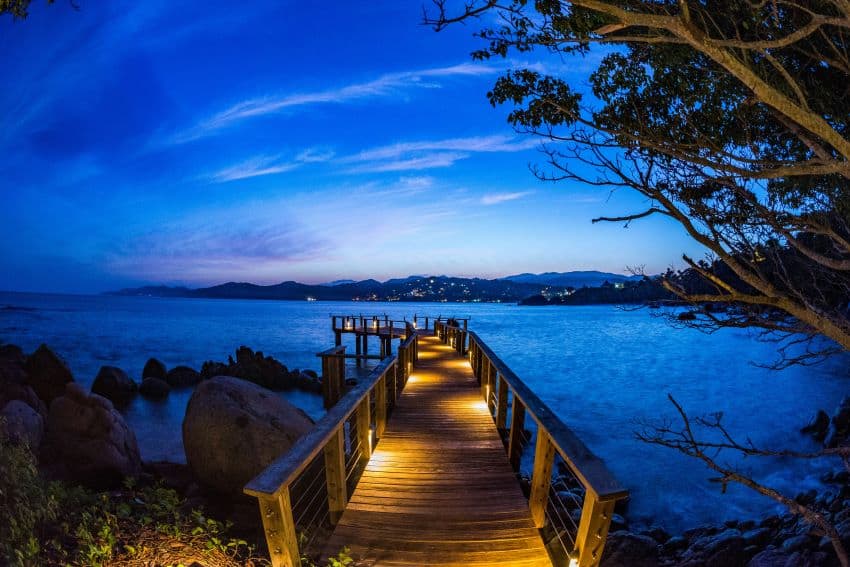
If you’ve heard of one town along the Riviera Nayarit, chances are it is the Pueblo Mágico of Sayulita. What started as a rugged, backpacker surf town has exploded into a bohemian coastal hotspot, complete with chic restaurants and cocktail bars, high-end boutique hotels, yoga studios, and plenty of local designer shopping.
Despite this evolution, visitors still come from all over the world to surf its wild waves. You’ll also find sun worshippers splayed all across Playa Sayulita, which is where the highest concentration of beach restaurants and bars are. Plenty of travelers come to Sayulita for its wellness component. Retreats are often held in eco-friendly boutique hotels buried within the jungle-covered mountains.
And you can’t come to Sayulita without indulging in a little retail therapy. Evoke the Spirit is a personal favorite for its local crafts that reflect the indigenous Wixárika culture. I also love Manyana for its ethically made clothing.
When the sun goes down, the streets of Sayulita start to heat up, from live music venues to restaurants with tables that spill out into the street. Cocktail bars have become increasingly popular here too. Try Escondido Bar or El Tiburón Sayulita.
San Pancho
Sayulita has certainly made quite the splash among the well-heeled, young traveler set. But for those who know the Riviera Nayarit and have seen it transform, Sayulita has become a little chaotic and overwhelming. The antidote to Sayulita is just up the coast in the neighboring village, San Pancho.
Short for San Francisco, San Pancho is often described as “Sayulita 15 years ago.” It’s much more low-key than Sayulita, but that vibe likely won’t last for long thanks to growing interest from travelers looking to explore the north.
I prefer San Pancho’s beach to Sayulita. It is a lot larger and, in my opinion, cleaner. You won’t find quite as many beach bars as you do in Sayulita, but for me, that’s part of the appeal.
Back from the beach, the small grid of sandy streets is flanked by small markets and shops, a growing number of more formal sit-down restaurants, and just a few cocktail bars. San Pancho does not have the late-night party scene that Sayulita does, but in all honesty, that’s what travelers love most about it.
Lo de Marcos
Even more like Sayulita’s days of yore is Lo de Marcos, just 15 minutes north of San Pancho. This predominantly local community is one of the most beautiful and less built-up beach towns along the Riviera Nayarit, and that’s what makes it so special. A broad stretch of golden sand curves around a gentle bay.
A colorful town square is surrounded by locally owned restaurants and a few small markets. Along each of the sandy cobblestone streets are small Mexican-style villas and a few charming resorts. If you are looking for a true Mexican beach town escape, Lo de Marcos may be exactly what you’re dreaming of.
The only recent change in this area is the opening of the One&Only Mandarina and the soon-to-open Rosewood Mandarina. While most resort guests typically stay on the property, just up the coast from Lo de Marcos, curious travelers are flocking in droves to discover its wind-swept, rugged shores. Things are quiet and low-key at the moment, but with time, you can expect to see Lo de Marcos grow much larger and busier, much like its neighbors Sayulita and San Pancho.
Rincón de Guayabitos
The next bead in the necklace of coastal communities in Rincon de Guayabitos. While nearby Lo de Marcos has managed to evade the spotlight of mainstream tourism, Guayabitos has grown into one of the most popular family travel destinations for snowbirds, as well as national tourists. They are drawn to the broad stretch of white sand beach, the colorful stalls and galleries selling souvenirs, and the extensive list of outdoor activities.
Development of Rincon de Guayabitos has been slowly building for the past three decades. It offers a good selection of all-inclusive hotels, as well as a variety of bungalows, bed & breakfasts, and vacation rentals.
Off the coast are two beautiful islands teeming with wildlife. Isla Coral and Isla Cangrejo are popular for bird watchers who come to admire the local migratory birds, from pelicans to blue-footed boobies.
Chacala
Push another half hour north and you’ll tumble onto the beaches of beautiful Chacala. The exact antithesis of Puerto Vallarta, or even Nuevo Nayarit, Chacala is about as dreamy and laid-back as it gets. With a year-round population of less than 500 people, it’s hard to imagine Chacala moving at anything above a snail’s pace.
That said, snowbirds and Mexican families do flock here during the winter months, but the energy never vibrates beyond a low hum. Accommodations are humble boutique hotels or vacation rentals — you will not find a single all-inclusive resort here.
The small bay is wrapped in jungle-covered hills with just a glimpse of palapa-topped colorful buildings peeking out from between the thick foliage. Here, most activity is around the beach, whether it’s snorkeling or kayaking, whale watching, or surfing. Fishing is a big activity here, too. The town isn’t exactly a culinary hotspot, but you’ll find a handful of beach restaurants selling a variation of basically the same thing: grilled fish, ceviche, seafood cocktail, and a few other staples.
For the most part, people come to Chacala to lay low, watch the sunset, and turn in early.
San Blas
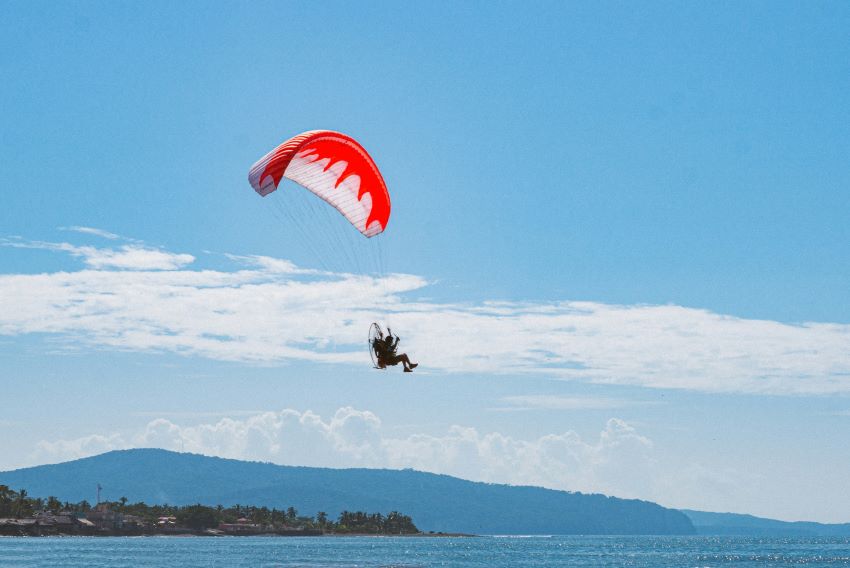
The last beach town you’ll come to along the Riviera Nayarit is the wildlife paradise that is San Blas. The town emerges froma bed of coastal plains that extend out to the Pacific Ocean, creating a marshy environment with palm trees and gorgeous, misty lagoons. Its broad, beautiful beaches are far from over-developed and the entire place has a castaway vibe that attracts nature lovers, surfers, and those looking to slip a little bit off the grid.
What brings many travelers to San Blas is the abundant wildlife. The town is known for its huge population of migratory birds. Not far from San Blas are several protected areas, like Isabel Island National Park and La Tovara National Park. The volcanic Isabel Island is about 70 kilometers off the coast and is an important refuge for seabirds. A total of 92 species have been recorded on the island, including blue- and red-footed boobies, pelicans, frigates, brown swallows, and many others. La Tovara National Park is a web of mangrove canals that create almost tunnel-like channels that bloom with colorful orchids and bromeliads. Keep your eyes peeled for crocodiles and sea turtles, who are the local residents of the waterways.
Meagan Drillinger is a New York native who has spent the past 15 years traveling around and writing about Mexico. While she’s on the road for assignments most of the time, Puerto Vallarta is her home base. Follow her travels on Instagram at @drillinjourneys or through her blog at drillinjourneys.com.
